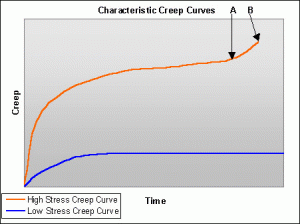 Creep
Creep
When subjected to load, all elastomers exhibit an increasing deformation with time, know as creep. This occurs at any stress level and takes place in compression, tension and shear loadings and varies for each type of loading. In service, creep can be minimized by using low working stresses and avoiding high temperatures. No rapid method has been developed for its measurement because there is no know way of accelerating time effects without introducing inaccuracies in predicting rate of creep.
Creep is usually expressed in percent of deformation after the part is loaded rather than the unloaded dimension. Determination of creep takes place after some arbitrary short time interval such as one minute, five minutes or even on day after applying the load. Creep, expressed as a percent, equals total deformation minus initial deformation divided by initial deformation, time 100. In the initial stage, creep occurs at a relatively high rate and then continues at a very slow rate. Failure can occur after an extended period of high stress.
Below the failure zone, when stress is removed, the part will attempt to return to its original dimension; however, it will never fully recover. The unrecoverable portion is called permanent set. Loads which allow intermittent recovery will exhibit less creep than if continuously loaded. However, continuous vibratory loading will increase creep since internal heat is generated.
Stress
Stress relaxation is the loss in stress when it is held at a constant strain over a period of time. It is usually expressed in terms of percent stress remaining after an arbitrary length of time at a given temperature.
There is no standard method for determining stress relaxation. However, many laboratories have developed relaxation cells. These cells utilize the compression set specimen and the test procedure parallels.



